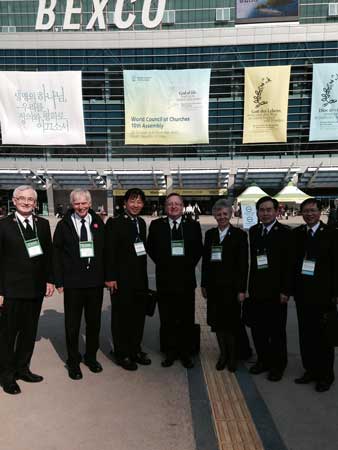By Robert Docter, Editor-In-Chief
There’s an extremely powerful advertisement designed by The Richards Group, the Army’s national advertising agency. It has a red kettle standing alone with a simple headline that reads: “EXPECT CHANGE.”
I’m sure you’ve seen it—hopefully on these pages.
Obviously, the word “change” in the ad has multiple meanings. The intended message, I believe, simply communicates that “giving” to the Army can facilitate social change. The kettle is almost an Army trademark. More than anything else in society, it—along with the Shield—says “The Salvation Army.” The ad, however, spreads itself across all seasons.
I wouldn’t want to change the content of the ad in any way, but I’m glad it’s not affixed to the kettle. To me it says, “Help us change the world.”
I’m interested in the word “change.” It’s happening at such a tremendous pace—“faster than a speeding bullet,” it seems.
In such a short period of time our world has shifted dramatically. We live in an age where electronic hand-held devices have taken control of our lives. Much of that is helpful. Much, as well, has imposed periods of isolation where the device has inhibited close social connection and conversation among people in close proximity, while expanding to those that are distant.
So, we tend to believe that “change” brings with it some positives and some negatives. If it’s minor, like an adolescent experiencing mood shifts, deal with it. But, if it’s major, second-order change that seems to hit like a social tide the size of a tsunami, about all you can do is cope.
That assumes some skill. Coping first requires a measure of acceptance. You recognize that this thing is too big to go away and has a life of its own. Then you need to find out what it’s all about and what it can do to and for you. I know some people who, to this day, resist owning or using computers. This is strange. Computers have monopolized most parts of our existence. However, for personal use, they are almost part of the past now with the arrival of the iPad and the iPhone. How’s that for rapid change.
The American automobile industry almost turned belly-up, ready to call it quits a few years ago. Rescued through Federal loans, the corporations that make up this industry faced the need for major change. They handled it well and survived. It’s nice to see GM once again No. 1 in the world.
So, the effect of change on society depends on our response to it.
Take values, for instance, another kind of change. Values are fairly consistent over time, but it’s possible to shift value orientations. We need to believe that as “salvation people.” A major change that takes place at conversion relates to the value assigned God. It changes from a self-centered orientation to one that is principle centered. This leads to changes in one’s belief system, changes in morality and changes in attitude. Changes in behavior patterns following conversion vary among seekers and depend a great deal on helping relationships from others.
It would be good to visit research examining various issues that change over time. For instance, researchers have discovered value shifts among larger populations that indicate changes in attitude, morality and beliefs.
Giacomino, Brown and Akers used classification methodology by Rokeach and Musser and Orke to determine shifts in value categories of a specific population of university students. They wanted to interpret societal value changes between generations.
The Rokeach Value Survey (RVS), developed by Milton Rokeach over 40 years ago, is the most used survey of its type. It has two sets of value labels with 18 in each set. The first focuses on what he calls terminal values. These words describe the values a person would like to achieve during a lifetime. Rokeach divides the 18 terminal values into two categories of nine values.
The first nine have a social focus on the qualities of relationships with others, and the second nine have a personal focus on self. Rokeach labeled the second set of 18 as instrumental values, also divided into two sections. The first identifies moral based means to achieve a goal and the second focuses on competence to achieve it. The subject ranks each value from 1 to 18.
Giacomino and his colleagues report findings that reveal changes in values of university students by survey participants between 1998 and 2010. Individuals of the same age participated in each of the two surveys. In 12 years, the generations changed labels from “x” generation to the “y” generation and also changed what they valued in their world.
VALUE PLACEMENTS
VALUE BETWEEN SURVEYS
National security Largest increase
Equality Large increase
Pleasure Large increase
Inner harmony Large increase
Social recognition Moderate increase
Freedom Large drop
Mature love Large drop
An exciting life Large drop
Health Moderate drop
Self-respect Moderate drop
So what? I wonder what all this means for us. Do we make automatic adjustment or are we fixated in our perception of age groups depending on our own age?
Yes, Virginia, there are data available to help us cope with our world.












